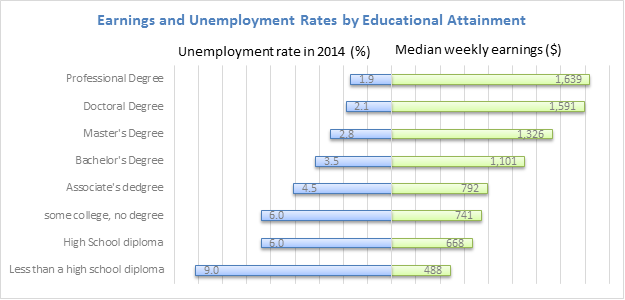By Dr. Mavuto Kalulu
The figure from the U.S. Department of Labor displays the unemployment rate and weekly earnings by education level earned.
Suppose that John graduated from high school at age 18 but his buddy Jacob dropped out. As the figure shows, John will earn $179 per week more than Jacob. In one year that earnings difference will total $8950.
Let’s further suppose that the two buddies stay on the same job until they retire at age 65, each receiving an annual pay increase of 3 percent. John will earn over $930,000 more than Jacob during his working life.
John could save or invest much of the salary difference and generate much more extra income for himself. But even if John does not invest any of his extra earnings, at today’s interest rates, that’s equivalent to handing John a check today for over $200,000.
A $200,000 payoff seems to be a pretty good return for the time and effort it takes to graduate from high school. But to earn that $200,000, John must complete high school. What if there were a way to increase John’s chances of graduating from high school?
The Council for American Private Education Outlook¹ reported that students enrolled in private high schools are far more likely than those enrolled in public schools to graduate, regardless of the student’s race or ethnicity.
According to the National Center for Education Statistics, in the 2010-2011 school year the national graduation rate for private schools was 97.8 percent compared to 79 percent for public schools. In other words, the probability of a student earning a $200,000 payoff is 18.8 percentage points greater for students who attend private schools.
Much of that difference will be due to differences in the backgrounds and circumstances of “private school families” relative to “public school families.” However, a student’s education is influenced by people other than parents. Peers and teachers matter. If a student is surrounded by peers who simply know they will graduate and by teachers who routinely expect that nearly all of their students will graduate, then she is more likely to expect that she, too, will do the work and “simply graduate,” regardless of her family circumstances.
How do we surround more of our children with these sorts of peers and educators? There is a solution to ensure that even low-income families can increase the chances of their children graduating from high school. It’s called an educational voucher program.
Nearly two years ago, former State Representative Randy Alexander and 11 other cosponsors² filed a bill to create an educational voucher program in Arkansas. Under the Arkansas Parental Choice Scholarship Program, the state would have given an eligible student a voucher worth 92% of the amount that the state would have allocated to the public school district for her education. She and her family would have used the voucher funds to attend the private school of their choice.
The Arkansas General Assembly’s Education Committee tabled the bill to study voucher systems in other states. Two years is enough time for study. Ample empirical research shows that voucher programs are used by and beneficial for disadvantaged students. They do not decrease public school per-pupil funding, but they do lead to improvements in public schools. As recent events in our state have shown, it’s time to try something radically different in Arkansas education. The old “solutions” have not solved anything. Let’s try something that has worked in other states. Let’s enable more Arkansas families to hand their children $200,000 “paychecks.”
If you have questions or comments, or if you would like more information about this study or about ACRE and its endeavors, please contact ACRE’s director David Mitchell (dmitchell@uca.edu).
DISCLAIMER The views and opinions expressed herein are those of the authors and do not necessarily reflect the views of the University of Central Arkansas nor are they endorsed by the University of Central Arkansas.
¹http://www.capenet.org/pdf/Outlook384.pdf
² The 11 other cosponsors were Representatives Bob Ballinger, Robert Altes, Andy Davis, Jim Doston, Charlene Fite, Justin Harris, John Hutchison, Mark Lowery, Micah Neal, John Payton and Sue Scott.

